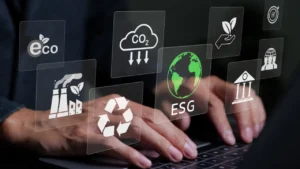Understanding the Carbon Footprint of Shopping Centers
A carbon footprint represents the total greenhouse gas (GHG) emissions produced directly and indirectly by a facility’s operations. For shopping centers, this footprint extends far beyond electricity bills. It includes the full life cycle of the building; from construction materials to daily energy use, tenant operations, visitor travel, and waste disposal. Understanding these emission sources is the foundation of any credible sustainability strategy.
Key Sources of Emissions in Shopping Centers
Source | Emission Type | Examples and Impact |
Energy Consumption | Indirect (Scope 2) | Lighting, HVAC systems, escalators, refrigeration units — typically 50–70% of a center’s emissions. |
Transportation | Indirect (Scope 3) | Vehicle emissions from customers, suppliers, and logistics fleets. |
Waste Management | Direct and Indirect | Methane from landfills, unsegregated food and packaging waste. |
Building Materials | Embodied Carbon | Emissions from the production and maintenance of steel, concrete, and glass. |
Each of these sources contributes differently depending on the center’s size, tenant mix, and energy profile. For example, food courts and supermarkets create higher waste-related emissions, while luxury malls may see more impact from air-conditioning and refrigeration loads.
Why Measurement Matters
Accurate data collection allows shopping centers to:
- Establish a baseline for future reduction targets.
- Identify underperforming systems and prioritize retrofits.
- Comply with GHG Protocol and ISSB-aligned disclosure standards.
- Evaluate return on investment (ROI) for energy and waste initiatives.
Modern centers are increasingly deploying digital systems such as smart meters, IoT-based sensors, and real-time dashboards to measure performance across key utilities. This technology-driven monitoring not only ensures accuracy but also provides predictive insights for maintenance and optimization.
The Strategic Importance of Emission Reporting
Once shopping centers understand the sources and magnitude of their carbon footprint, the next step is translating data into structured emission reporting. Reporting is a strategic business function that bridges operational performance, stakeholder trust, and financial opportunity.
Emission reporting provides visibility across all environmental aspects of a facility. By systematically recording and disclosing emissions, shopping centers move from assumptions to evidence-based management. For example, when a facility quantifies emissions from air conditioning, transport, or waste, it can identify which area yields the greatest potential for reduction. This precision allows decision-makers to prioritize interventions that offer both environmental and economic returns.
Why Emission Reporting Matters for Business?
A well-structured emission reporting process supports multiple strategic priorities:
Objective | Strategic Value |
Regulatory Compliance | Aligns with evolving regional and global disclosure requirements such as the UAE Net Zero 2050 initiative, GHG Protocol, and ISSB. |
Operational Efficiency | Enables data-driven decisions that lower utility costs, optimize energy use, and improve maintenance schedules. |
Reputational Credibility | Builds trust with customers, tenants, and investors through transparent disclosure. |
Financial Access | Positions centers for green financing, sustainability-linked loans, and tax benefits. |
In markets such as the UAE, emission reporting is increasingly tied to investment attractiveness. Malls and mixed-use developments that publish verified sustainability reports are more likely to secure long-term leases from global tenants, who themselves are under pressure to meet ESG criteria.
Frameworks and Methodologies for Measuring Emissions
Accurate carbon reporting requires a well-defined methodology built on internationally recognized standards. For shopping centers, selecting the right framework ensures consistency, comparability, and credibility in reporting outcomes.
The Greenhouse Gas (GHG) Protocol is the most widely adopted global standard for emission measurement. It categorizes emissions into three scopes that together create a comprehensive reporting structure:
Scope | Definition | Examples in Shopping Centers |
Scope 1 – Direct Emissions | Emissions from sources owned or controlled by the facility. | Fuel use in backup generators, refrigerant leaks from HVAC systems, and company vehicles. |
Scope 2 – Indirect Emissions | Emissions from purchased electricity, heating, or cooling. | Power consumption for lighting, air conditioning, escalators, and refrigeration. |
Scope 3 – Value Chain Emissions | Emissions from activities not owned or directly controlled by the center but related to its operation. | Customer transportation, tenant operations, supply chain logistics, and waste disposal. |
Accurate reporting requires centers to map all three scopes using a mix of quantitative data (e.g., energy usage, waste volume, transport logs) and qualitative information (e.g., procurement practices, waste diversion policies). The objective is not only to disclose emissions but to contextualize them within broader sustainability performance.
Integrating Global Reporting Frameworks
To ensure comparability and enhance investor confidence, many shopping centers align their emission reporting with additional frameworks:
- GRI (Global Reporting Initiative): Encourages transparent sustainability disclosures across environmental and social performance.
- SASB (Sustainability Accounting Standards Board): Focuses on industry-specific ESG metrics relevant to financial performance.
- TCFD (Task Force on Climate-related Financial Disclosures): Helps organizations report on climate-related risks and governance structures.
- ISSB (International Sustainability Standards Board): Consolidates sustainability reporting globally, integrating financial and non-financial disclosures.
These frameworks work best when combined within an integrated sustainability management system. For example, a shopping center can use the GHG Protocol for emission measurement, align reporting with GRI standards, and apply TCFD guidelines to disclose climate risks.
The Path Toward Carbon Neutrality
Once a shopping center has established a clear emissions baseline and aligned its reporting frameworks, the next strategic goal becomes achieving carbon neutrality. In practical terms, carbon neutrality means that the total greenhouse gas emissions generated by the facility are fully balanced by an equivalent amount of emission reductions or removals. It is the ultimate indicator of environmental responsibility, but reaching this target requires careful planning, sustained investment, and cross-departmental collaboration.
Building a Roadmap to Carbon Neutrality
Achieving carbon neutrality is best approached as a phased process, with each stage focusing on measurable improvements:
Phase | Objective | Key Actions |
1. Reduction | Minimize emissions at the source. | Upgrade HVAC and lighting systems, optimize operational schedules, adopt energy-efficient appliances, and reduce water consumption. |
2. Replacement | Transition toward renewable and low-carbon energy. | Install rooftop solar panels, sign renewable power purchase agreements (PPAs), and utilize smart energy management systems. |
3. Offsetting | Neutralize unavoidable emissions. | Invest in verified carbon offset programs such as reforestation, renewable energy generation, or methane capture projects. |
4. Verification | Validate performance through third-party audits. | Obtain independent verification aligned with ISO 14064 and pursue recognized certifications like LEED, BREEAM, or Estidama. |
These four phases form an integrated roadmap that allows retail property managers to implement and scale sustainability efforts in a structured manner.
Aligning Carbon Goals with Business Objectives
For shopping centers, carbon neutrality should not exist in isolation from financial or operational objectives. The transition to cleaner energy and resource efficiency often delivers direct cost savings through reduced energy bills and maintenance expenditure. Moreover, investors and international retail brands are increasingly incorporating carbon neutrality into their partnership selection criteria, meaning centers that act early can secure long-term commercial advantages.
Leadership commitment is equally important. A carbon-neutral strategy requires consistent executive oversight, transparent progress reporting, and employee engagement. Embedding sustainability KPIs across procurement, facility management, and tenant operations ensures that environmental goals are not confined to sustainability departments but become part of organizational culture.
Emerging Trends Defining the Next Decade
- Integration of ESG with Financial Reporting:
Investors are now assessing ESG performance alongside traditional financial metrics. This trend is being driven by global frameworks such as ISSB and CSRD, which merge sustainability disclosures with corporate reporting. Shopping centers that demonstrate financial resilience through sustainable operations will attract stronger capital flows and long-term tenants.
- Real-Time Carbon Monitoring:
The next generation of retail infrastructure will adopt Internet of Things (IoT) and AI-powered energy management systems. These technologies will monitor utilities in real time, predict inefficiencies, and automatically adjust lighting and temperature settings to optimize energy use. This data-driven approach enhances both sustainability and cost efficiency.
- Shift Toward Net-Positive Impact:
Carbon neutrality is only the starting point. Future sustainability leaders will move toward net-positive models, meaning they contribute more environmental value than they consume. This includes restoring biodiversity, capturing carbon beyond their operational footprint, and investing in local renewable projects.
- Collaboration Across the Value Chain:
Shopping centers will increasingly coordinate with suppliers, tenants, and logistics providers to create integrated sustainability ecosystems. Shared sustainability KPIs and data transparency will redefine how malls and tenants collaborate commercially.
- Policy-Driven Compliance:
Governments are tightening environmental regulations, particularly around disclosure, waste management, and energy performance. Centers that already possess verified carbon data and reporting mechanisms will seamlessly adapt, while laggards may face compliance penalties and restricted access to funding.
Conclusion: Turning Sustainability into Strategy with IFRSLAB
The shift toward carbon accountability is redefining what makes shopping centers competitive. Energy efficiency, emission transparency, and sustainability reporting are the markers of leadership in the modern retail landscape.
Every data point tells a story: how responsibly a center operates, how efficiently it manages energy, and how seriously it treats its environmental footprint. The ability to measure, report, and act on this data separates forward-thinking retail assets from those playing catch-up.
At IFRSLAB, we help shopping centers make this transition seamlessly. Our ESG and carbon accounting solutions turn complex environmental data into clear, verifiable insights that support compliance, attract investors, and enhance reputation. We align your reporting with global frameworks such as GHG Protocol, ISSB, CSRD, and TCFD, ensuring credibility that withstands scrutiny.
What sets our approach apart is practicality. We build systems that last. From setting emission baselines to achieving carbon neutrality, our experts design step-by-step frameworks that link sustainability goals with measurable financial outcomes.
Carbon reporting is about demonstrating vision. Shopping centers that act today will shape the retail spaces of tomorrow, making them efficient, transparent, and trusted.
With IFRSLAB, sustainability becomes more than a statement. It becomes your business advantage.





